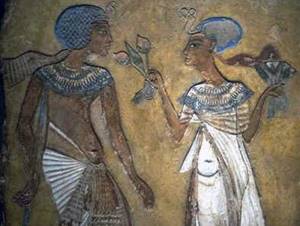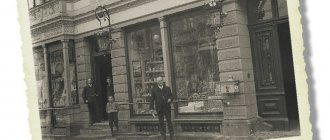Nefertiti shaved her head and wore four earrings
Computer reconstruction of Nefertiti's face.
British Egyptologist Joanna Fletcher searched for the famous Queen Nefertiti all her life. She spent the last two years on expeditions studying ancient mummies. And the other day, Fletcher made a sensational statement: her team managed not only to find and “identify” Nefertiti’s mummy, but also to recreate the beauty’s appearance.
Joanna is a renowned expert on ancient Egyptian hairstyles. In the Cairo Museum, she saw a Nubian-style wig next to the mummy. These were worn only by the rulers of the 18th dynasty - it was then, in the 14th century BC, that the ancient country was ruled by Pharaoh Akhenaten and his wife Nefertiti! Fletcher grabbed this thread and began to dig further. It turned out that the mummy of the most famous Egyptian woman was found in the tomb numbered KV35 in Luxor. But until now no one has thought that this is the legendary Nefertiti!
Two forensic experts came to Fletcher's aid - Damian Schofield and Martin Evison - masters in reconstructing the appearance of a murder victim from the skull. The swan's neck and chiseled profile were immediately visible, although the mummies were almost 3 thousand years old! But the woman’s face was thoroughly damaged - apparently, she was violated by tomb robbers.
On a three-dimensional computer model of the skull, experts “increased” virtual muscles and skin, expressive oriental eyes, plump lips... And when the royal crown was added to the portrait, everyone gasped: Nefertiti was looking from the monitor! Her face is known to everyone thanks to the famous bust kept in the Berlin Museum. "I was amazed! - Joanna recalls. “Nefertiti’s beauty is so individual that you can’t confuse her with anyone else!”
By the way, in reality the pharaoh’s wife looked a little like a modern punk! The beautiful Nefertiti shaved her head so that she could wear a huge crown. And she had two earrings in each ear! Forensic experts confirmed that the mummy's earlobes were pierced and there was no hair on her head. Then the mummy was x-rayed. It turned out that the queen’s gold jewelry was preserved in the chest broken by the robbers.
The Egyptians were skeptical about Joanna Fletcher's discovery. “Her conclusions may be wrong, and the evidence may be inconclusive! - said the head of the Egyptian Council of Antiquities Zahi Hawass. — It cannot be said that the mummy belongs to Nefertiti just because it looks like a sculpture. In those days, artists depicted the embellished appearance of rulers, and not real facial features.”
Nefertiti
Nefertiti is the most beautiful and happiest Egyptian queen, the beloved and only wife of Pharaoh Akhenaten. Excavations that were carried out in the 20th century led to more and more legends surrounding Nefertiti’s estate. But there is also reliable information about her life, love and death.
Nefertiti - one of the most famous ancient Egyptian queens
It is generally accepted that Nefertiti was not Egyptian. She was from the Mesopotamian state of Mitanni, the country of the Aryans. You can even say that she came to Egypt from the Sun itself, because her people - the Aryans - worshiped the Sun. As soon as a 15-year-old princess named Taduchepa appeared on Egyptian soil, a new god appeared - Aten.
Nefertiti became the wife of Pharaoh Amenhotep III, but this marriage was purely political. The young beauty was exchanged for a ton of jewelry, gold, silver and ivory and brought to the Egyptian city of Thebes. There she was named Nefertiti and given to the harem of Pharaoh Amenhotep III. When the pharaoh died, Nefertiti was inherited by his son Amenhotep IV. It is worth noting that the pharaoh did not immediately fall in love with the beauty. However, after some time this happened, as a result of which the young pharaoh decided to dissolve his father’s harem and declare his wife his co-ruler.
Nefertiti's wife was sometimes portrayed as a weak, strange and sickly young man who strove for equality, peace and friendship between people and different nations. It was Amenhotep IV who carried out a religious reform, which none of the rulers who occupied the throne in Egypt dared to undertake.
A huge temple of Aten was built from white stone. The new capital of Egypt was founded in the valley between Thebes and Memphis. The city was called Akhetaten (“Horizon of Aten”). The pharaoh's wife played a significant role in this event; she was an inspiration. The pharaoh himself began to be called Akhenaten, which means “pleasing to Aten,” and Nefertiti - “Nefer-Nefer-Aten.” This name is translated very beautifully - the beautiful beauty of Aten, or the face like the sun.
Archaeologists from France managed to restore the appearance of Nefertiti: black eyebrows, strong-willed chin, full, gracefully curved lips. The queen's figure was quite fragile and miniature, beautifully built. She wore expensive clothes, most often white transparent dresses made of thin linen. Her favorite headdress was a tall blue wig entwined with gold ribbons and a uraeus, which was a symbol of her connection with the formidable goddesses, the daughters of the Sun. Nefertiti was glorified as a gentle beauty, the favorite of the Sun, bringing peace to everything in the world.

As it turned out, the life of the king and queen was not cloudless. Nefertiti had a rival
Akhenaten called his wife “the delight of his heart” and wished her to live “forever and ever.” It was believed that Akhenaten and Nefertiti had an ideal family, that they lived in family happiness until their death. This myth has become worldwide. However, archaeologists still got to the bottom of the tragedy that overshadowed the life of the beautiful Nefertiti. It turned out that she had a rival. How did they manage to figure this out? Of course, hieroglyphs and images on stone slabs helped them in this. The fact is that the king and queen were usually depicted as an inseparable couple. They were symbols of mutual respect, together they met noble guests, together they prayed to the disk of the Sun, and distributed gifts to their subjects. And in 1931, in Arman, the French discovered tablets with hieroglyphs on which the name Nefer-Nefer-Aten was carefully scraped off, but the name of the pharaoh was left.
Then the finds became even more amazing. For example, a limestone figure of Nefertiti’s daughter was found with her mother’s name destroyed, as well as a profile of the queen herself, whose royal headdress was covered with paint. Only Pharaoh could order this. Based on all this, Egyptologists had no choice but to assume that a drama had occurred in the Pharaoh’s house. The family broke up. This happened several years before the death of Akhenaten. Nefertiti was expelled from the palace. She settled in a country house and raised a boy who was to become the husband of her daughter, the future Pharaoh Tutankhamun.
The place under the images of the royal couple was not empty. Another female name appeared there - Kiya. This is exactly the name of Nefertiti’s rival. In 1957, archaeologists also discovered an image of the new queen, who had a very youthful face, wide cheekbones, regular arched eyebrows, and a calm look. Surprisingly, a year before his death, Akhenaten also removed this wife.
Nefertiti lived in exile until Tutankhamun's accession to the throne. She died in Thebes. And when Akhenaten died, the priests of Egypt hastened to return to the old god. The name Nefertiti was cursed along with the god Aten.
According to another version of Nefertiti’s life, the queen appears in a completely different image. She is experienced in love, voluptuous and cruel. This Nefertiti told a young man in love with her a fable about a woman who did not want to be “despised.” Therefore, for her love, she demanded that the lover give her everything he has, drive away his wife, kill the children and throw their bodies to the dogs. The queen brought to life the plot of the fable. She drove the unfortunate man away. This Nefertiti herself fanned the fire of enmity in her husband Akhenaten, she hated him and wanted him dead. Every year she bore him daughters, accusing him of not being able to have a son.
Nefertiti - beauty is comingText
Alina Renik
Nefertiti - beauty is coming
Chapter 1
1887, Egypt
Morning found the woman on the road. The east was getting brighter, the crimson sun was slowly rising in a grayish haze, pink shadows were sliding along the slopes of the mountains, giving them unusually beautiful outlines. But the woman had no time for the beauty of the early morning. She had a long journey ahead of her, and the burden was heavy, the rope from the bag cut into her shoulder and its contents hit her legs painfully with every step. But she walked and walked, and the sand covered her tracks...
The sands shifted unsteadily, revealing the secrets of eternal Egypt...
* * *
A few days ago, on her tiny plot of land, a woman dug up strange clay tablets, dotted with sticks, dots and scratches. There were so many tablets, and they were preserved so well that even an illiterate peasant woman understood that this was an opportunity to make money. In another country, such finds pass by the attention of local residents, but not the Egyptian fellahs!
1
Fellah is a settled peasant.
Europeans pay generously for any antiquity.
The woman was going to Luxor to sell her find - tablets with only sticks and dots on them.
Having walked a long way, tired and exhausted, she entered the Museum of Antiquities. Hesitantly, she stopped at the door and with a sigh of relief took the heavy bag off her shoulder. She was afraid to go forward, afraid to turn to the museum employee who was moving some boxes from place to place, afraid that her find would only cause laughter from such a serious scientist. And it was a shame to tear him away from his very important work.
Several times she tried to talk to him, but he just waved her off. He had no time for her! New artifacts have been brought - mummies of iconic ibises - and everything needs to be accepted, inventoried and sorted. Hasan, who had recently received a place in the museum, so wanted to prove himself, to show his zeal, that the woman with the big bag only irritated him with her importunity and worthless clay tablets. On such tablets in Ancient Egypt, children learned to read and write, until they were allowed to write on more expensive material - papyrus. And there are already thousands of such tablets in storage!
But, taking another quick glance at the sign she was holding in her hands, and...
* * *
And his attention was attracted by even, clear signs. They didn't look like children's scribbles!
Unfortunately, while moving the signs in the bag, the woman severely damaged some of them, turning them into dust.
– Where are you from, dear? - he asked.
“From Amarna,” the woman answered quietly.
“Yes?..” he drawled in surprise, remembering that he had already been near this village. – I remember, I remember... A very interesting place! You have boundary steles there and tombs in the mountains! Why are there so many of them? No one was buried in them?!
The woman shrugged her shoulders tiredly:
- Don't know…
- Dear, wait a minute, I’ll think of something. But it seems to me that these tablets are not of particular value, most likely they are school notebooks,” he said, glancing sideways at the bag, and for some reason he felt a sinking feeling in the pit of his stomach. Doubt crept into my soul. - Wait!
“We need to show them to Said,” thought Hasan, “He knows ancient languages and will certainly distinguish historical value from “trash of history.”
Hassan ran down to the storage room.
- Said. Said,” the voice rang loudly through the labyrinths of the warehouse and echoed loudly.
- What is there? Said responded, leaving the farthest room.
- Clay tablets! The woman brought a whole bag! She says she found it. She is from the village of Tel el-Amarna.
“I’ve never heard of this,” Said said, coming closer. He was short and thin.
– This is a village in a small valley, surrounded on three sides by mountains, with the fourth, naturally, by the Nile. There are mountains with cave-in tombs.
- Phew, Allah, as he said! “As I read,” Said smiled.
“Yes, I... I was there,” Hassan blushed, paused for a while and started babbling again. “They spent a whole season excavating in these mountains, or rather, in the tombs, but it seems that no one ever rested in them, although the tombs themselves are very beautiful. I have never seen such drawings anywhere. They are drawn somehow differently, somehow unusual... as if they were alive... Well, the people on them seem to be alive. But the valley itself is not noticeable; there are not even temples or any buildings there. Only border steles, like those that Hatshepsut liked to erect. Only they may have some value. I think the woman brought either school signs or the archives of one of the nomes. It’s a pity for her, she went through such a path!
- Well, let's go, buddy, and have a look. The steles of Queen Hatshepsut mean something,” Said said.
“No, no, there were no steles of Hatshepsut, I know them well,” Hassan became worried. – I simply compared those from Amarna with the steles of Hatshepsut that stand here. – And he waved his hand to the side, as if pointing to the majestic obelisks that had towered over the city for more than three thousand years.
“Well, well, don’t fuss,” Said patted him on the shoulder. - Let's go have a look.
They went out into the hall, where the tired traveler was waiting for at least some answer. His arms hung like whips, a bag with signs lay on the floor. She shifted from foot to foot and fingered the tassels on an old scarf, nervous that she had to come all this way because of worthless signs.
- Peace to you!
- And you!
- Dear, what made you come?
– I found this. “She sat down and opened the bag, where there were several dozen clay tablets, half of which already resembled simple shards. “There are a lot of them there, they were in large boxes, but the wood has already decayed and dried out. And how would I bring them...
Said bent down and took one of the tablets: the clay was smooth, the signs were very clear and even, but nothing special! Regular cuneiform.
“Dear, I’m very sorry that you have come such a long way, but I can’t buy them from you,” saying this, Said looked at the poor woman, “his heart sank from the despair in her eyes.” - Okay... I'll give you some... here, take it...
Handed her a few










